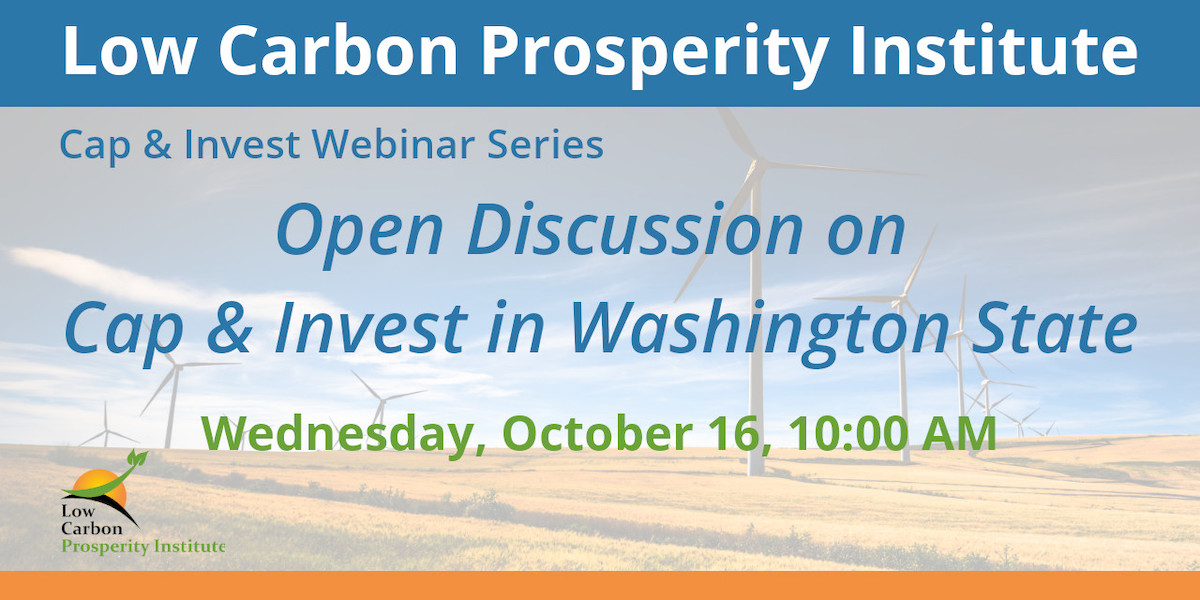CaPI Webinar Series:
Cap & Invest in Washington State
Webinar Q&A: Introduction to Cap & Invest in Washington State
Is it true that RGGI GHG reduction stalled during the Great Recession because need for energy declined and there was no political will to reduce the cap?
Shorter answer
While the initial RGGI cap for 2009 was much higher than emissions ended up being, there is peer-reviewed research that estimates power sector emission would have been 24% higher without RGGI.[1] At the very least, it is believed that “the revenue generated from the emissions allowance sales likely had some impact on emission levels in the region” (Congressional Research Office) even if the economic downturn and market-led coal to natural gas shifts might have had a bigger impact on power sector emissions. Program adjustments from a design review in 2012 showed political will to strengthen and lengthen the program, resulting in much more stringent caps (a 45% reduction in the 2014 cap) and adjustments of up to 20% of the cap in certain years to account for the large amount of banked allowances from the early period of the program. Even spanning the recession, RGGI power emissions declined nearly three times more than the rest of the country while economic growth was better. Coal power declined by 70% in RGGI states but only by one-third outside of RGGI states.
More detailed answer
It is generally agreed that RGGI resulted in some emissions reductions from the power sector, even during the Great Recession. The cap was established in 2005 at expected levels for 2009 emissions, while actual emissions in 2009 turned out to be substantially lower. A Congressional Research Office (CRS) report describes the impact of this as “limiting its ability to compel regulated entities to make internal emission reductions or purchase emission credits from other sources” which were due to several factors including an economic downturn and a market-led shift from coal to natural gas power. The CRS report also notes that “the revenues generated from the emission allowance sales likely had some impact on emission levels in the region.” One separate, peer-reviewed study published in 2015 in the journal Energy Economics, concluded that projected power sector emissions would be 24% higher without RGGI.[2]
Whatever the direct impact, RGGI acknowledged that the initial cap was far too high for the program to have a full impact, and that banked allowances from that time period could compromise future cap years. In a show of political will, the program has now been extended through 2030 indicating the net program effect has been positive — but with much more stringent caps. A design review in 2012 led to a 45% reduction in the 2014 cap (from 165 million tons to 91 million tons). The design review also included cap adjustments for the large volume of banked allowance since the cap was too high initially, lowering the cap by as much as 20 million tons in certain years.
One compelling point of comparison is RGGI versus the rest of the country. According to a Ceres factsheet, between 2009-2014 RGGI power emissions declined 35% (through fuel-switching from coal to natural gas, improved energy efficiency, and growing renewable energy output) compared to 12% for the rest of the country, and the RGGI states experienced better economic growth.
It is difficult to see how the RGGI cap along with investments and long-term program goals would not have impacted RGGI outpacing the rest of the country in power sector emissions decreases. No matter what the short-term direct impact in the face of an unanticipated recession, gaining long-term support with increased ambition is a win for the program. Overall, the electricity cap, trade, & invest program for RGGI has done well enough that an agreement is now in place to develop a similar system to cap and reduce transportation emissions that make up 39% of the regions total emissions.
[1] Brian C. Murray and Peter T. Maniloff, “What Have Greenhouse Emissions in RGGI States Declined?” Energy Economics, September 2015
[2] Ibid.
Watch: Introduction to Cap & Invest in Washington State
This webinar provides a high-level summary of Cap & Invest and what it would mean for different business sectors and communities. We will also discuss how stakeholders can participate in shaping the policy.
Next Webinar: Open Discussion on Cap & Invest in Washington State
Wednesday, October 16, 10:00 AM
This webinar will be an open discussion on the Cap & Invest system under development in Washington state. We’re interested in your suggestions, advice, and concerns. Our emphasis will be on resolving concerns and problems, and strengthening pathways to our twin goals – prosperity up & emissions down.
Get involved in this landmark project! It’s a safe place to express yourself.

